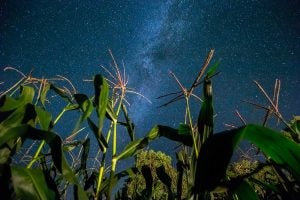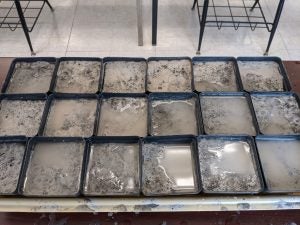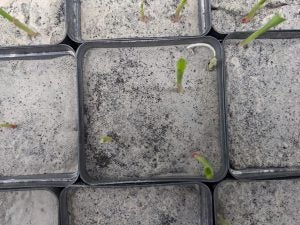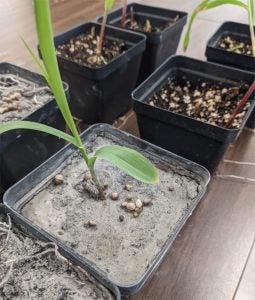As a child, I was a casualty of fleeting interests. Even then, only one at a time. Unable to multitask, I would doggedly immerse myself until the mania wore off — only to be replaced by the next suitor. My self-diagnosis? A textbook case of the “phases.”
Those phases, in no particular order, included paleontology (what kid doesn’t marvel at the sight of dinosaurs and the like?), Garbage Pail Kids (’80s fad), numismatics (coin collecting), and astronomy. I vividly remembering checking out the same astronomy book from the library. I’d obsessively page through, comparing the relative sizes of the planetary bodies, as well as orbital distances. I was spellbound.
For a time, I fancied myself an astronaut on a mission to the outer reaches of the known galaxy. I don’t regret my whirlwind flings, much of that residual knowledge still comes in handy (except the Garbage Pail Kids, I suppose).

Look to the stars — it’s a common theme throughout human history. Dreaming about the vast expanse and possibilities of space.
What are our motivations? Perhaps our infatuation is the product of fear — fear that Earth’s resources are being stretched thin. Eco-hypochondriacs would emphatically agree. So would pop culture. The Hollywood flick Interstellar was premised on interplanetary resettlement in the face of a global environmental crisis.
I’m not convinced of the urgency. In my view, it’s a pipedream to even consider a mass exodus. It’s just too energetically expensive to shuttle a few — let alone an entire — population elsewhere. Our focus should stay decidedly “earthly.”
Despite that, globetrotting moguls have already laid the groundwork with self-financed off-world jaunts. As we transition to a spacefaring society, proponents will argue a need to retrofit space stations into capable greenhouses, while terraforming lifeless, otherworldly landscapes into a lush oasis. Assuming our fates are written in the stars, how can we leverage agricultural lessons from Earth to provide food, fiber, and fuel for space pioneers?
The first step is to consider the soil, specifically lunar soil. How well can it sustain crops? My crop science class got some first-hand experience with the Plant the Moon Challenge. At its core, this is a crowdsourced exercise designed to develop and share best practices for growing crops in a simulated lunar soil.

Why simulated? Well, the Apollo 11 crew didn’t collect and bring back much soil from their touchdown (and subsequent antics) on the lunar surface. Instead, a best guess was formulated on Earth and distributed for use.
As participants, our charge was to develop a management plan and compare it to a typical soil (we chose a standard greenhouse potting mix). Before starting the project, we noticed some stark differences in the lunar soil. For one, it had a lifeless, drab gray color, was very fine (easily inhaled), had poor porosity and water infiltration (water would puddle on the surface after watering), poor aeration, and high compaction (not quite as solid as a concrete block, but close, with considerable heft).
This was the polar opposite of the potting mix we used — organic, light, and airy. To be fair, potting mix has been fine tuned for decades. It’s expressly engineered to work well in a variety of crop environments.
After a class “congress,” we agreed on the experimental design and doled out our limited allowance of lunar soil into 4-inch pots, planted some corn seeds, and gave the pots 12 hours of artificial light per day. All were periodically watered. This procedure was mirrored with the greenhouse treatments as well.

The corn seedlings struggled mightily in the lunar soil. Germination was delayed, with poor vigor compared to the greenhouse mix. There was a distinct, almost impermeable crust at the top.
After three weeks, the lunar soil corn seedlings had largely caught up with their greenhouse mix brethren. We then applied fertilizer at the same rate, leaving controls in both types. Have to have a baseline for comparison, after all.

As an added wrinkle, the class opted to treat some of the pots (both soil types) with a plant “probiotic” called Organic Plant Magic to invigorate the biology. This product is formulated with a variety of microorganisms that provide various services to the plant root, like nutrient scavenging, enhanced bioavailability, and other benefits. These were kept separate to avoid contamination with untreated pots.
Students developed their hypothesis, namely that the addition of the fertilizer and/or probiotic wouldn’t be enough to overcome the very profound physical and chemical limitations of the lunar soil. In the end, this was largely borne out. Bottom line, lunar soil is severely impaired, and would require considerable investment to be on par with Earth’s most middling soils.
Interestingly, in an unrelated trial, a team at the University of Florida was given some bona fide lunar soil to test. Small dust samples, cobbled together from the Apollo missions, were used to grow a type of cress (cabbage relative). Surprisingly, the seeds germinated after two days.
After about six days, clear differences emerged. The seedlings showed evident signs of stress. Ultimately, they were stunted. The cause(s) weren’t reported in the article, but poor soil characteristics were presumably a contributing factor. Lunar soil just doesn’t have the same degree of development from the elements (or biological organisms) to transform it into the vivacious, lifegiving medium we value. Despite that, the study wasn’t a total loss. Like any scientific endeavor, data spurs cross-disciplinary investigations.
Consider limiting factors here on Earth, especially soil in marginal areas, or otherwise unimproved. The potential also exists to identify and address plant stressors that limit productivity. With an ever-decreasing ag footprint, this is a gamechanger.
Despite our fascination with the stars, it’s ironic that such efforts are reflexively useful here on Earth. It seems our work on this unremarkable blue sphere (as the NBC sitcom called it, the 3rd Rock from the Sun) isn’t a passing phase — it still demands attention.
Tim Durham’s family operates Deer Run Farm — a truck (vegetable) farm on Long Island, New York. As an agvocate, he counters heated rhetoric with sensible facts. Tim has a degree in plant medicine and is an Associate Professor at Ferrum College in Virginia.



